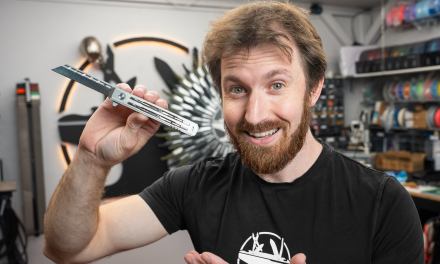Amaze’s Aaron Day on AI, data-driven product design, and what 1M creator stores reveal about the creator commerce revolution.
If you’re a creator looking to launch a product in 2025, here’s the hard truth: content alone won’t cut it.
As CEO of Amaze, Aaron Day has seen it all — from 15K-follower crab accounts raking in six figures to NBA stars selling branded merch during their championship parades. His platform supports over 13 million creator stores, which gives him a unique view into what actually works.
“You can’t just drop a product and expect people to buy it,” Day says. “You need data, you need promotion, and you need a plan.”
In this episode of Creator Commerce, Day breaks down why pre-sales are fading, how AI is reshaping product design, and what separates real brand-builders from short-term sellers.
This conversation is part of the Creator Commerce series Brought to You by .store Domains
Launching a product line? Start with a .store domain — the go-to web address for creators selling online. Top names like MrBeast, Dude Perfect, and Colin & Samir trust .store to build sleek, memorable URLs like YourName.store that drive traffic and sales. Get yours today at go.store/boc10.
A Shift Toward Smarter, Data-Driven Creation
Creators used to launch whatever came to mind — a t-shirt here, a mug there — and hope something stuck. Not anymore.
Today, creators are harnessing AI to generate product ideas based on video content, and — more importantly — they’re finally asking who they’re selling to.
“They’re saying, ‘Can you show me data on my audience? What do they like? What are they buying?’” Day explains. “That shift alone has dramatically increased success rates.”
Instead of guessing, creators are building products with actual market signals. It’s part of a broader evolution toward brand thinking — moving beyond merch drops to building sustainable businesses.
From Pet Crabs to Parade Floats: Launch Strategies That Work
Day’s team has worked with everyone from NBA star Alex Caruso to YouTube storyteller Howie the Crab. Despite their wildly different audiences, the most successful launches all share one trait: community integration.
Take Howie the Crab, a micro-creator with only 15,000 followers. By deeply engaging her audience in the storytelling and product development process, she converted over 60% of her community — generating more than $280,000 from her first drop.
“She didn’t just sell a product. She made them part of the story,” Day says.
On the flip side, Alex Caruso’s merch line took off because it was timely, authentic, and persistently promoted. After his team won the NBA Championship, he didn’t just launch and leave. He wore the merch in interviews, gave it away, tied it to charity — and kept the momentum going.
Want to Succeed? Promote, Promote, Promote
No matter the audience size, Day insists: creators must actively sell.
“If you’re not promoting your store, your chances of success are very, very small.”
Creators often fear seeming inauthentic — but platforms like YouTube, TikTok, and Instagram now make it easier than ever to sell within the content. Whether it’s tagging products in a livestream, linking through stories, or activating YouTube’s product shelf, the most effective campaigns integrate commerce into the viewing experience itself.
Plus, Day notes, TikTok Shop has shifted the culture:
“It’s made creators more comfortable with selling. Even if they’re not full QVC, they realize — you can talk about your product without it feeling gross.”
Three Ways Creators Can Sell on Amaze
Amaze offers creators three primary selling paths:
- Digital Products – Courses, PDFs, exclusive videos. Creators keep full margin beyond a base platform fee.
- On-Demand Products – Apparel, home goods, jewelry, etc., with wholesale pricing and built-in design tools (including Adobe AI).
- Custom Products – Fully personalized items like wine or plushies, often involving global manufacturing partners.
Each model is designed to be low-lift on operations. Creators don’t handle fulfillment or logistics — they just focus on the idea and promotion.
“You can go from design to live store in five minutes,” Day says. “And if you integrate it with your platform, your revenue multiplies.”
What AI Actually Does for Creator Commerce
Forget replacing creativity. Amaze is using AI to amplify it — particularly around market insights and fan data.
With over 2 billion store visits and 200 million verified fans, the platform can build lookalike audiences and help creators refine who they’re targeting and what they’re selling.
“We tell a yoga creator with 10K followers: hey, we have 8 million yoga-interested fans. Want access?” Day explains. “That’s AI working for the creator.”
Design-wise, generative AI has dramatically sped up store builds. What used to take months now takes days. And creators can test products with zero inventory risk.
Why Pre-Sales Are Fading — and What’s Replacing Them
Scarcity drops had their moment, but Day believes pre-sales are now more a capital problem than a strategy.
“No fan wants to wait four months for a product. Creators are only doing pre-sales because they lack access to financing.”
That’s why Amaze is increasingly focused on building pathways to credit and capital. By connecting creators’ platform data, engagement metrics, and sales history, they’re working to help creators fund production upfront — no long wait times required.
Brand Collabs, Powered by Data — Not Just Agencies
What’s next for the creator economy? Aaron Day predicts a boom in tech-enabled brand collaborations.
“We’re going to see creators and brands come together in a much more scalable way — not just one-off agency deals, but platform-driven partnerships based on data and audience alignment.”
With tools like Amaze’s distribution layer and fan intelligence, this shift could help creators monetize in ways that feel organic, not forced. Brands tap into niche communities, and creators get support without losing control.
Key Takeaways for Creators and Brand Builders
- Know your audience: Use social and fan data to understand what your community actually wants.
- Involve your fans: The most successful creators co-create products with their audiences.
- Don’t be shy about selling: If you won’t promote it, don’t expect anyone to buy it.
- Think beyond merch: Build a real brand with lifecycle thinking, not just one-off drops.
- Let AI help you: From idea generation to audience expansion, AI can power your store.






